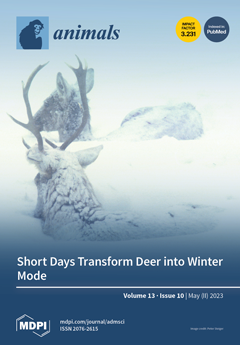The possible effect of heat stress (HS), measured with the temperature–humidity index (THI) across seasons of the year (SY) upon milk production (MP), feed-to-milk efficiency (FME), and cow comfort (CC) was assessed in Holstein–Friesian cows in northern-arid Mexico. Data from 2467 cows (2146 milking and 321 dry) were recorded across SY [spring (SP), summer (SM), autumn (AT), and winter (WN)] between 2016 and 2019 in an intensive dairy farm located in the Comarca Lagunera (25° NL) with large fluctuations regarding ambient temperature and solar radiation. The THI was stratified into four classes: non-HS, <68; light HS, 68–71; moderate HS, 72–76; and intense HS, ≥77. The considered response variables were Milk production: both on a farm basis (totMP) and on a cow basis (cowMP); Nutritional efficiency: dry matter intake (DMI, kg); Feed conversion efficiency (FCE, kg) and energy-corrected milk (ECM, kg); Percentage of milking cows: (MC%); and Cow comfort: lying time (LT, h). Analyses of variance for unbalanced data were performed through “R”. Both totMP and cowMP differed (
p < 0.05) as HS increased; the largest values (i.e., 77,886 L and 35.9 L) occurred at lower THIs (i.e., <68 and 68–71) while the milk production fell (i.e., 66,584 L and 31.7 L) with the highest THIs (i.e., ≥77). Not only feed-to-milk efficiency (i.e., DMI, FCE, and ECM) but also the MC% exhibited a similar trend; a visible drop (
p < 0.05) occurred from a THI of 68–71 onwards. Furthermore, the LT declined as the THI augmented, from 10.6 h at <68 to 8.5 h at ≥77. Moreover, differences (
p < 0.05) also arose across seasons; TotMP, cowMP, DMI, FCE, and ECM revealed their largest (
p < 0.05) values in WN and SP, halfway ones in AT, with the lowermost figures in SM. In the same way, cow comfort differed (
p < 0.05) among seasons, with diverse lying times (h); WT, 10.5; AT, 10.20; SP, 9.3 h; and 8.8 in SM. Finally, the potential economic burden that HS caused at the producer (USD 233.2 million) and industry-market levels (USD 311.1 M), as well as its impact upon nutrient and alimentary security at the society level (i.e., 311 M milk liters and 195,415.82 Gcal), were also quantified.
Full article






